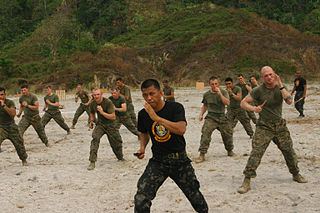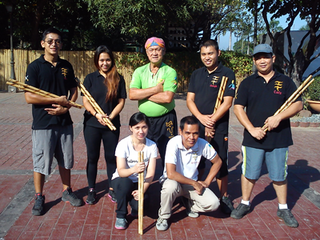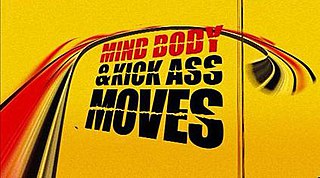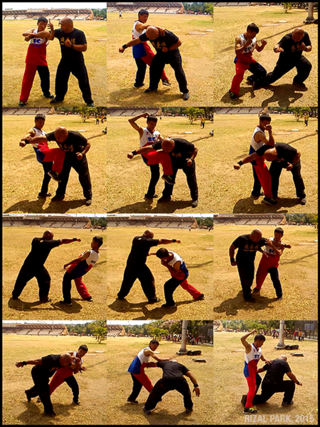
Filipino martial arts (FMA) refer to ancient and newer modified fighting methods devised in the Philippines. It incorporates elements from both Western and Eastern Martial Arts; the most popular forms of which are known as Arnis, Eskrima, and Kali. The intrinsic need for self-preservation was the genesis of these systems. Throughout the ages, invaders and evolving local conflict imposed new dynamics for combat in the islands now making up the Philippines. The Filipino people developed battle skills as a direct result of an appreciation of their ever-changing circumstances. They learned, often, out of necessity on how to prioritize, allocate and use common resources in combative situations. Filipinos have been heavily influenced by a phenomenon of cultural and linguistic mixture. Some of the specific mechanisms responsible for cultural and martial change extended from phenomena such as war, political and social systems, technology, and trade and practicality.

Arnis, also known as kali or eskrima/escrima, is the national martial art of the Philippines. These three terms are, sometimes, interchangeable in referring to traditional martial arts of the Philippines, which emphasize weapon-based fighting with sticks, knives, bladed weapons, and various improvised weapons, as well as "open hand" techniques without weapons.

Stick-fighting, stickfighting, or stick fighting, is a variety of martial arts which use simple long, slender, blunt, hand-held, generally wooden "sticks" for fighting, such as a gun staff, bō, jō, walking stick, baston, arnis sticks or similar weapons. Some techniques can also be used with a sturdy umbrella or even with a sword or dagger in its scabbard.

Modern Arnis is the system of Filipino fighting arts founded by Remy Presas as a self-defense system. His goal was to create an injury-free training method as well as an effective self-defense system in order to preserve the older Arnis systems. The term Modern Arnis was used by Remy Presas' younger brother Ernesto Presas to describe his style of Filipino martial arts; since 1999 Ernesto Presas has called his system Kombatan. It is derived principally from the traditional Presas family style of the Bolo (machete) and the stick-dueling art of Balintawak Eskrima, with influences from other Filipino and Japanese martial arts.
Doce Pares is a Filipino martial art and a form of Arnis, Kali and Eskrima, that focuses primarily on stick fighting, knife fighting and hand-to-hand combat but also covers grappling and other weapons as well. In reality, the stick is merely considered an extension of the hand, and is meant to represent almost any weapon, from sticks to swords to knives to anything else you can place in your hand and use as a weapon in the modern context. Doce Pares was founded in 1932.
San Miguel Eskrima is one of the major systems of eskrima, a martial arts from the Philippines. Founded by Filemon "Momoy" Cañete of the Doce Pares Club, SME served as vehicle for his own personal expression of the art and methodology of the club of which he was a co-founder and instructor. The name San Miguel is taken from Michael (archangel), the slayer of Satan, and is one of the major strikes used in Eskrima.

Remy Amador Presas was the founder of Modern Arnis, a popular Filipino martial art. Born in the Philippines, he moved to the United States in 1974, where he taught his art via seminars and camps. In 1982 he was inducted into the Black Belt Hall of Fame as Instructor of the Year. He published several books and videos on Modern Arnis and is recognised as the "Father of Modern Arnis".

Balintawak Eskrima or Balintawak Arnis is a Filipino martial art created by Grandmaster Venancio "Anciong" Bacon in the 1950s to enhance and preserve the combative nature of arnis which he felt was being watered down by other styles of Philippine martial arts. It is named after a small street in Cebu where it was founded.
Tim Hartman is a practitioner of the Filipino martial art of modern arnis and balintawak eskrima, and the president of the World Modern Arnis Alliance (WMAA).

Pekiti-Tirsia Kali is a style specific to Filipino martial arts. Pekiti-Tirsia Kali was founded in 1897 and is the system of the Tortal family. The sole heir and guardian of this system is Leo Gaje. Pekiti-Tirsia is strictly a combat-oriented system, as opposed to a sport-focused fighting style. It is a fighting system that focuses on edged, impact, and improvised weapons. PTK has been adopted as one of the preferred combative training programs by several elite military and law enforcement units around the world. It is considered a highly lethal method of self-defense.

Grandmaster Vicente "Vic" R. Sanchez was a Filipino martial artist and the founder of Kali Arnis International.

Sibat is the Filipino word for spear, used as a weapon or tool by natives of the Philippines. The term is used in Tagalog and Kinaray-a. It also called bangkaw, sumbling or palupad in the islands of Visayas and Mindanao; and budjak among Muslim Filipinos in western Mindanao and the Sulu Archipelago.
Ciriaco "Cacoy" Cañete was a Filipino martial artist of the Doce Pares Eskrima Club. He was the last surviving member of the club, which was founded in January 1932. He was also a 12th degree black belt. His version of the Doce Pares Eskrima system is known as Cacoy Doce Pares. In 1951 he developed a personal system of his named Eskrido.

Mind, Body & Kick Ass Moves is a television programme broadcast on BBC Three. Presented by Chris Crudelli the documentary series travels around the Far East exploring different martial arts and learning the secret skills and knowledge of the 'Grandmasters'. The series investigates aspects of each different martial art by filming the masters demonstrating their style and skills. There is one series of 10 episodes. Each episode focuses on a mix of different martial arts and masters and shows Crudelli taking some martial arts and tricks to the streets, in a style similar to street magic. The opening narration states Crudelli is a master of combat and esoteric energies.
Garimot Arnis is a Filipino martial art developed by Gat Puno (Chieftain) Abon "Garimot" Baet. He is the 5th generation inheritor of his family art. Garimot Arnis is a system composed of three basic parts: arnis de mano (weapons), buno (wrestling), and hilot (healing). The defining characteristic of the system is in keeping yourself safe. This is done by meticulously studying the footwork, angles, and distancing of largo mano to keep yourself out of your opponent's range while keeping him in your range. In corto (close) range, the opponent's ability to attack must be shut down as quickly as possible, through a disarm, lock, or manipulation of the opponent's body, which sets up the finish. Above all, knowledge of hilot allows you to keep yourself healthy by helping to fight illness and injuries, especially injuries caused during arnis and buno training.
Arnis in popular culture reflects the impact that the Filipino martial arts of arnis/eskrima/kali have made outside of the martial arts community. The three terms are roughly interchangeable and for the purpose of convenience, the term arnis will be used throughout the article. These arts emphasize weapon-based fighting with sticks, blades, improvised weapons and hand-to-hand fighting which is formally known as Mano Mano or Pangamut. Because of this training with live weapons, elements of arnis have made an impact in film, video games, television, and comic books. Arnis is often used to train actors and stuntmen how to handle similar weapons for use in movies.
Black Scorpion Arnis is a distinct Filipino martial art first developed in the late 1960s that focuses on self-defense. The hands and feet are used extensively in most of the styles moves.

Suntukan is the fist-related striking component of Filipino martial arts. In the central Philippine island region of Visayas, it is known as Pangamot or Pakamot and Sumbagay. It is also known as Mano-mano and often referred to in Western martial arts circles of Inosanto lineage as Panantukan. Although it is also called Filipino Boxing, this article pertains to the Filipino martial art and should not be confused with the Western sport of boxing as practiced in the Philippines.

The baston is one of the primary weapons of Arnis and Filipino martial arts. It is also known as yantok, olisi, palo, pamalo, garrote, caña, cane, arnis stick, eskrima stick or simply, stick.












